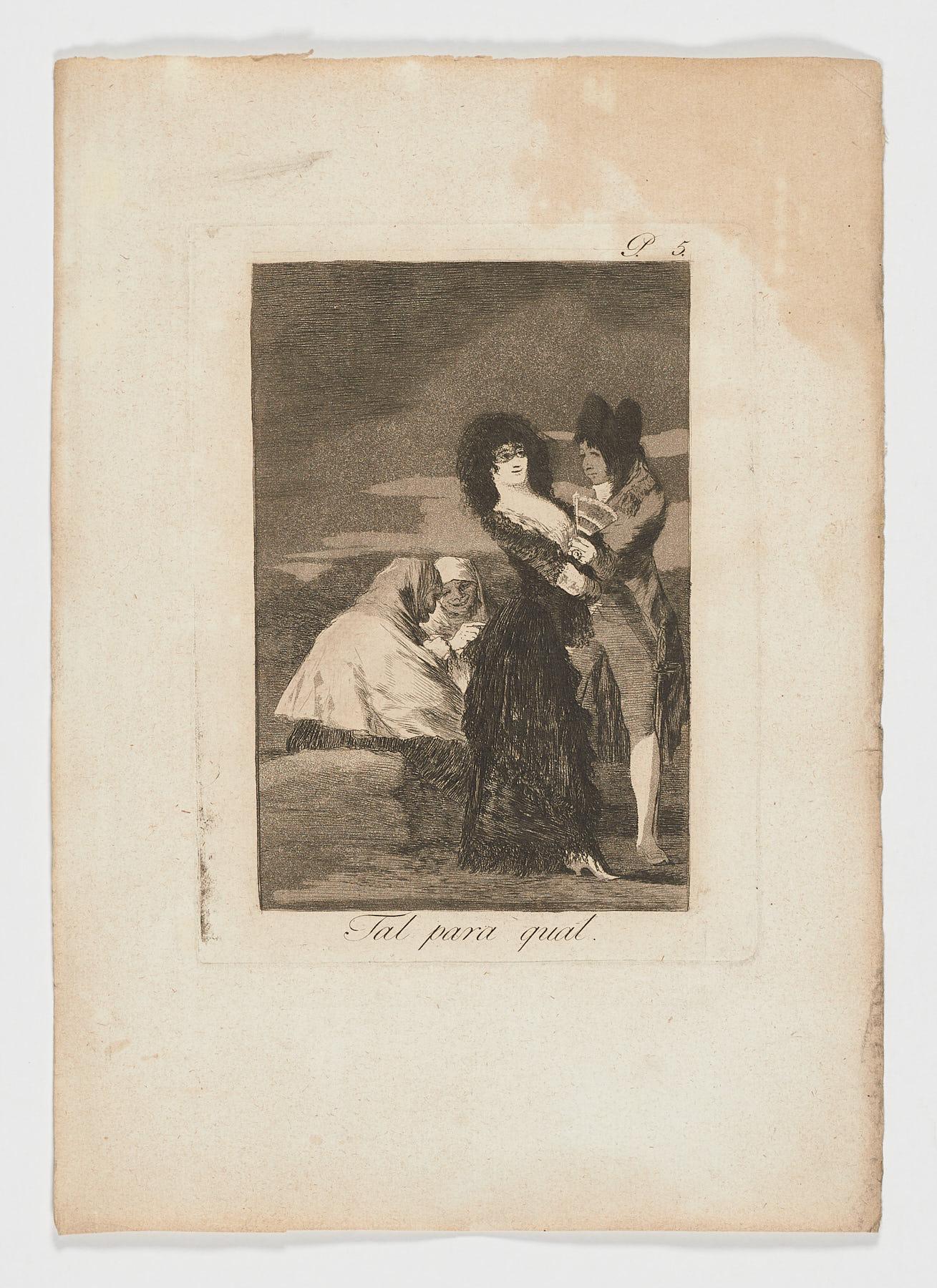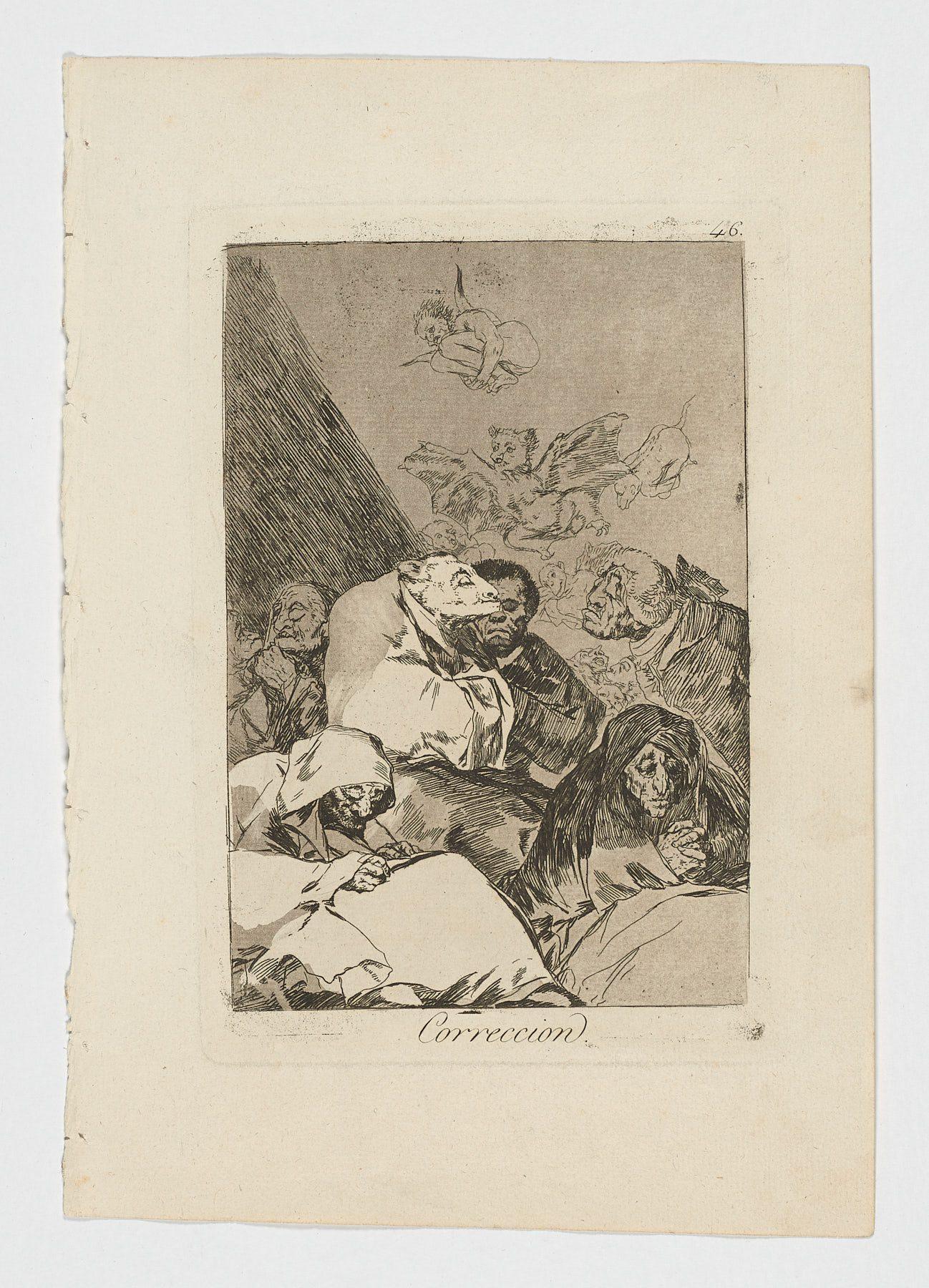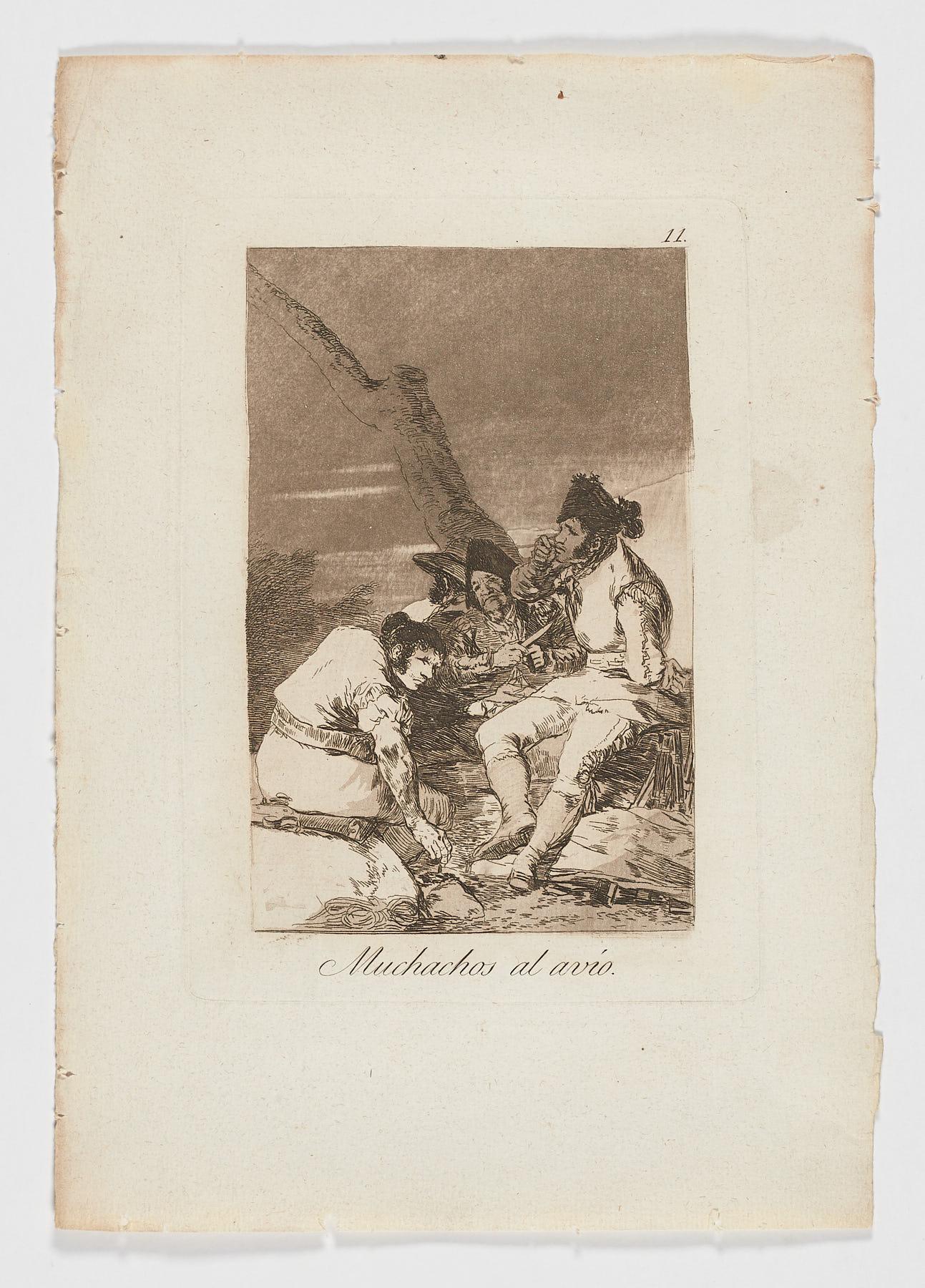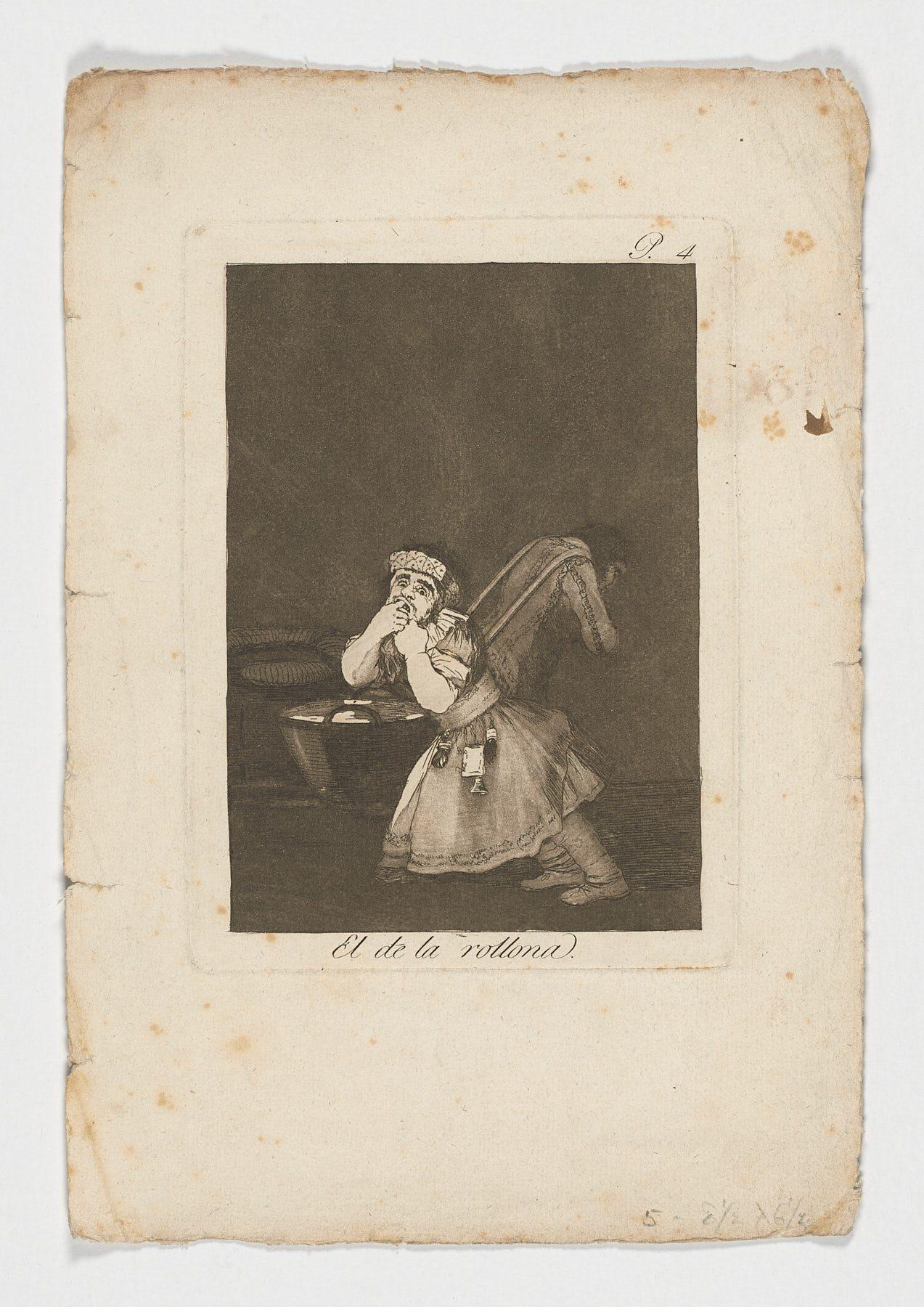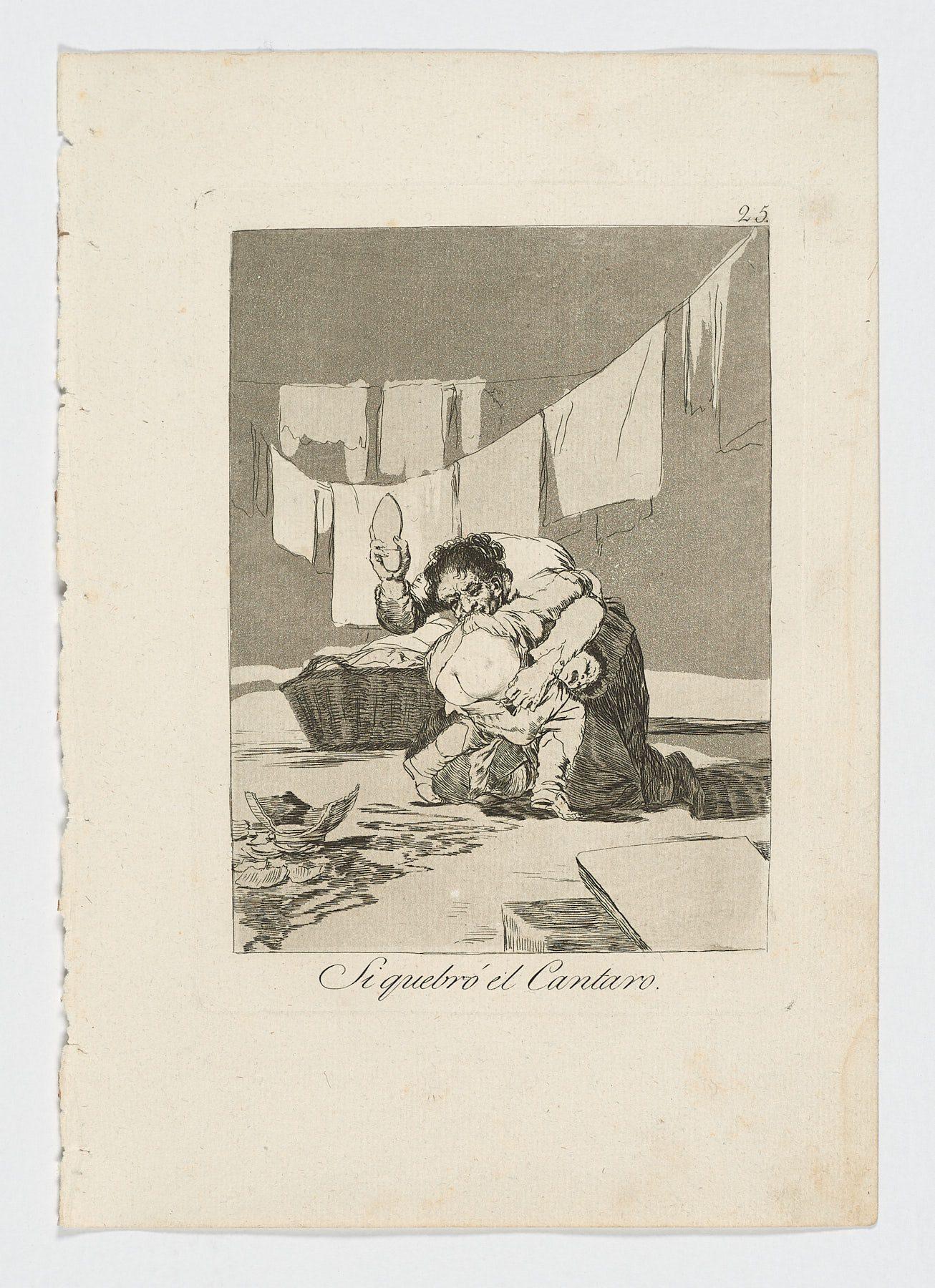Items Similar to Francisco De Goya Caprichos Hasta la muerte 2nd edition original art print
Want more images or videos?
Request additional images or videos from the seller
1 of 3
Francisco GoyaFrancisco De Goya Caprichos Hasta la muerte 2nd edition original art print ca.1881-1886
ca.1881-1886
About the Item
Francisco De Goya (Spain, 1746-1828)
'Hasta la muerte (Caprichos. Estampa 55)', ca.1881-1886
burnished aquatint, etching on vellum paper
12.1 x 8.2 in. (30.8 x 21.1 cm.)
2nd Edition (1855)
Conservation: Restored print. Aquatint in very good condition. Iron without bevel
Provenance: Calcografía Nacional
Unframed
ID: GOY2001-014
It is documented in the Catalog Raisonné: Goya engravins and lithographs, Volume II. Thomas Harris. Bruno Cassier Oxford, 1964. Pag. 130. Nr 90.
_________________________________________________________________
Francisco José de Goya y Lucientes was a Spanish painter and printmaker. His work includes easel and mural painting, engraving and drawing. His style evolved from Rococo, through Neoclassicism, to Pre-Romanticism, always interpreted in a personal and original way, and always with an underlying trait of naturalism, the reflection of reality without an idealistic vision that sweetens or distorts it, where The ethical message is equally important. For Goya, painting is a vehicle of moral instruction, not a simple aesthetic object. His most contemporary references were Giambattista Tiepolo and Anton Raphael Mengs, although he was also influenced by Diego Velázquez and Rembrandt. Goyesque art represents one of the turning points that between the 18th and 19th centuries herald contemporary painting and is a precursor of some of the pictorial avant-garde of the 20th century, especially expressionism; For all these reasons, he is considered one of the most relevant Spanish artists and one of the great masters of world art history.
Furthermore, his work reflects the turbulent historical period in which he lived, particularly the War of Independence, of which the series of prints of The Disasters of War is almost a modern report of the atrocities committed and composes a vision devoid of heroism where The victims are always individuals of any class and condition.
His naked Maja has great popularity, partly favored by the controversy generated around the identity of the beautiful woman portrayed. Other portraits that embark on the path towards new bourgeois art also date from the beginning of the 19th century. At the end of the Spanish-French conflict he painted two large paintings about the events of the May 2 uprising of 1808, which established both an aesthetic and thematic precedent for the history painting, which not only comments on events close to the reality he lives. the artist, but reaches a universal message.
Among his other works, his culminating work includes the Disparates, as well as the series of oil paintings on the dry wall, the black paintings, with which he decorated his country house, the Quinta del Sordo. In them Goya anticipated contemporary painting and the various avant-garde movements that would mark the 20th century and are, according to J. M. Matilla, head of Conservation of Drawings and Prints at the Museo Nacional del Prado, "the first manifestations of Goya's truly modern character, who we should not hesitate to describe as the first modern artist.
Goya's work includes some five hundred oil paintings and wall paintings, as well as nearly three hundred etchings and lithographs and hundreds of drawings. The majority is preserved in the Prado Museum in Madrid, although there are also a good number of works in France, especially in the Louvre Museum, as well as those in Agen, Bayonne, Besançon, Castres, Lille and Strasbourg.
(Source: Wikipedia, the free encyclopedia)
- Creator:Francisco Goya (1746 - 1928, Spanish)
- Creation Year:ca.1881-1886
- Dimensions:Height: 12.1 in (30.74 cm)Width: 8.1 in (20.58 cm)
- Medium:
- Movement & Style:
- Period:1790-1799
- Condition:
- Gallery Location:Miami, FL
- Reference Number:1stDibs: LU1854213326272
About the Seller
5.0
Vetted Seller
These experienced sellers undergo a comprehensive evaluation by our team of in-house experts.
Established in 2000
1stDibs seller since 2022
63 sales on 1stDibs
Typical response time: 1 to 2 days
- ShippingRetrieving quote...Ships From: Miami, FL
- Return PolicyA return for this item may be initiated within 14 days of delivery.
More From This SellerView All
- Francisco De Goya Caprichos Si quebró el Cantaro 1st edition original art printBy Francisco GoyaLocated in Miami, FLFrancisco De Goya (Spain, 1746-1828) ¨Si quebró el Cantaro¨ Series Caprichos. Estampa 25, ca.1797-1799 etching, aquatint, dry point on laid paper 11.6 x 8.1 in. (29.3 x 20.5 cm.) 1st...Category
1790s Romantic Prints and Multiples
MaterialsLaid Paper, Etching, Aquatint
- Francisco De Goya Caprichos El de la rollona 1st edition original art printBy Francisco GoyaLocated in Miami, FLFrancisco De Goya (Spain, 1746-1828) 'El de la rollona". Serie Caprichos. Estampa 04, ca. 1797-1799 burnished aquatint, etching on laid paper 12.6 x 8.6 in. (32 x 21.8 cm.) 1st Editi...Category
1790s Romantic Prints and Multiples
MaterialsLaid Paper, Etching, Aquatint
- Francisco De Goya Caprichos Tal para cual 1st edition original art print SpanishBy Francisco GoyaLocated in Miami, FLFrancisco De Goya (Spain, 1746-1828) ¨Si quebró el Cantaro¨'Tal para cual¨ Serie Caprichos. Estampa 05, ca.1797-1799 etching, aquatint, dry point on laid paper 12.4 x 8.7 in. (31.3 ...Category
1790s Romantic Prints and Multiples
MaterialsLaid Paper, Etching, Aquatint
- Francisco De Goya Caprichos Muchachos al avio 1st edition original art printBy Francisco GoyaLocated in Miami, FLFrancisco De Goya (Spain, 1746-1828) ¨Muchachos al avío¨ Series Caprichos. Estampa 11, ca.1797-1799 etching, aquatint, dry point on laid paper 12.4 x 8.7 in. (31.3 x 22 cm.) 1st Edi...Category
1790s Romantic Prints and Multiples
MaterialsEtching, Laid Paper, Aquatint
- Francisco De Goya Caprichos Correccion 1st edition original art print SpanishBy Francisco GoyaLocated in Miami, FLFrancisco De Goya (Spain, 1746-1828) ¨Correccion¨ Serie Caprichos. Estampa 46, ca.1797-1799 etching, aquatint on laid paper 11.6 x 8.1 in. (29.3 x 20.5 cm.) 1st Edition Iron without ...Category
1790s Romantic Prints and Multiples
MaterialsLaid Paper, Etching, Aquatint
- Francisco De Goya Caprichos Mucho hay que chupar 2nd edition original art printBy Francisco GoyaLocated in Miami, FLFrancisco De Goya (Spain, 1746-1828) 'Mucho hay que chupar (Caprichos. Estampa 45)', ca.1797-1799 burnished aquatint, etching on vellum paper 12.2 x 8.4 in. (30.8 x 21.1 cm.) 2nd Edi...Category
1790s Romantic Prints and Multiples
MaterialsEtching, Laid Paper, Aquatint
You May Also Like
- Le Compliment & Les Bouquets, pair French aquatints by Debucourt , 1787 and 1788Located in Melbourne, Victoria'Le Compliment ou La Matinee du Jour de L'an, Dediee aux Peres de Famille' (The Compliment, or New Year's Morning, Dedicated to the Fathers of the Family) and it's pair 'Les Bouquets...Category
Late 18th Century Romantic Figurative Prints
MaterialsAquatint
- Woman with FruitsLocated in San Francisco, CAThis artwork "Woman with Fruits" c.1980 is an original color aquatint by noted 20th century Bolivian Artist Norha Beltran. It is hand signed and numbered...Category
Late 20th Century Romantic Figurative Prints
MaterialsAquatint
- A Cart RaceBy Thomas RowlandsonLocated in Fairlawn, OHA Cart Race Hand colored etching & aquatint, 1788 Signed in the plate (see photo) Published by William Hollande, London Inscribed in the plate with title, artist's name and publication line 'Rowlandson. 1788./ London. Pubd 1789 by Wm Holland No 50. Oxford Street.' Reference: M.Dorothy George, 'Catalogue of Political and Personal Satires in the British Museum', VI, 1938) British Museum Satires 7607 Grego, 'Rowlandson', i. 260, Grego II.392 Provenance: Chris Beetles Ltd., London (label), 2003 Jeffrey M. Kaplan, Washington, D.C. (label) Condition: Excellent Archival framing by Chris Beetles Ltd., London Note: The British Museum has two impressions, one trimmed the other full sheet as this example. Accession Number: 1868,0711.35 The Metropolitan Museum has an impression: Accession number 59.533.314 Fitzwilliam Museum: Accession number: 34.14-286 Cleveland Museum of Art accession number: 1958.10 Image description per BM: Three ramshackle two-wheeled carts drawn by wretched horses race (right to left) against a background formed by the church... Note: The British Museum has two impressions, one trimmed the other full sheet as this example. Accession Number: 1868,0711.35 The Metropolitan Museum has an impression: Accession number 59.533.314 Fitzwilliam Museum: Accession number: 34.14-286 Cleveland Museum of Art accession number: 1958.10 Image description per BM: Three ramshackle two-wheeled carts drawn by wretched horses race (right to left) against a background formed by the clouds of dust which they have raised, with a row of gabled houses (right) inscribed 'St Giles', terminating in a church spire (left), and probably representing Broad St. Giles. The occupants of the carts are Irish costermongers typical of St. Giles. The foremost horse gallops, urged on by the shouts of a standing man brandishing a club. The other occupants, two women and a man, cheer derisively the next cart, whose horse has fallen, one woman falling from it head-first, another lies on the ground. The driver lashes the horse furiously. The third cart, of heavier construction, is starting. The horses are partly obscured by the clouds of dust, but denizens watch from casement windows and a door. Two ragged urchins (right) cheer the race; a dog barks. "It was said that the amount of copper Thomas Rowlandson etched would sheathe the British Navy. An inveterate gambler, for much of his life Rowlandson had to produce a flood of his comic prints to stay ahead of financial losses.A wealthy uncle and aunt raised Rowlandson after his textile-merchant father went bankrupt. His career developed quickly. He entered London's Royal Academy Schools in 1772, visited Paris in 1774, exhibited at the Royal Academy in 1775, and won a silver medal in 1777. He left school in 1778 to set up in business. Rowlandson's depictions of life in Georgian England exposed human foibles and vanity with sympathy and rollicking humor. During the 1780s he consolidated the delicate style he used for his coarse subjects. He worked mainly in ink and watercolor, his rhythmic compositions, flowing line, and relaxed elegance inspired by French Rococo art...Category
1780s Romantic Figurative Prints
MaterialsAquatint
- Durham Cathedral - English SchoolLocated in Middletown, NYEtching with aquatint on cream laid paper with a partial Arches watermark, 5 3/8 x 4 inches (135 x 100 mm), full margins. Signed illegibly in pencil in the lower right margin.Category
Early 20th Century Landscape Prints
MaterialsLaid Paper, Etching, Aquatint
- Shadows of VeniceBy John Taylor ArmsLocated in Middletown, NYEtching and aquatint on antique laid paper, wide margins. Signed, dated and inscribed "Edition of 100" in pencil, lower margin. Second state (of 2)....Category
Mid-20th Century American Modern Landscape Prints
MaterialsAquatint, Laid Paper, Etching
- From the Ponte Vecchio, FlorenceBy John Taylor ArmsLocated in Middletown, NYEtching and aquatint on hand made F.J. Head & Co watermarked cream laid paper, full margins. Signed and dated in pencil, lower right margin. From the edition of 160 (from a total of ...Category
1920s American Modern Landscape Prints
MaterialsHandmade Paper, Laid Paper, Etching, Aquatint
Recently Viewed
View AllMore Ways To Browse
J Barnes
British Railroad
Japanese War Horse
Keith Haring Ink
Dtr Modern Galleries Dali
Banksy Tank
Roy Lichtenstein Cathedral
Provence End Tables
South Railway
Sunday B Morning 1990
Torbjorn Rodland
Vintage French Pmu
Yu Cha Art
Michael Boyer Lounge
Crazy Numbers
France Railroad
Candle In Window Painting
Large Antique French Fashion Prints
